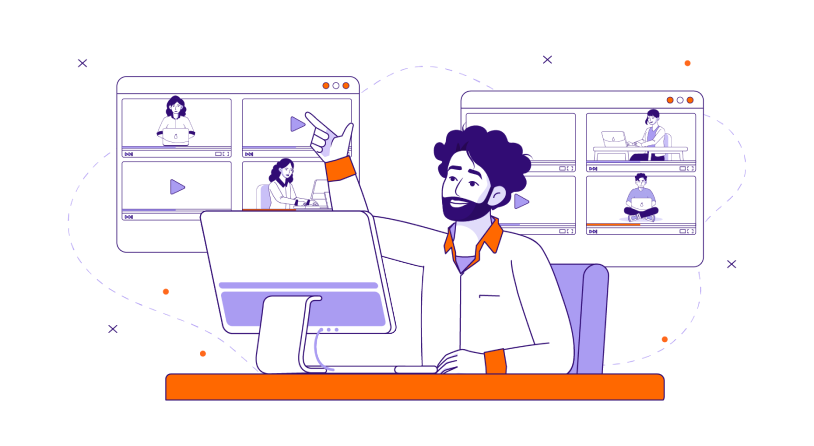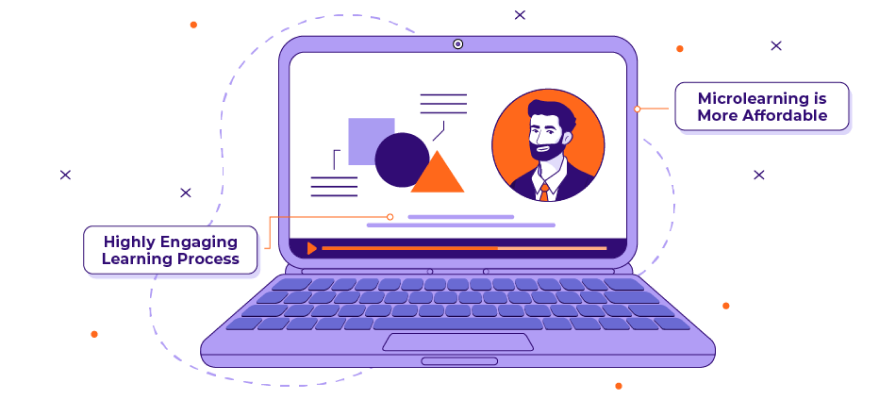
5 Benefits of Microlearning for Businesses & Non-Profit Organizations

Let’s be honest, the benefits of microlearning for both businesses and non-profit organizations are vast. In today’s busy and chaotic society, we’re busier than ever before.
In fact, interruptions disrupt our focus anywhere between 4 to 12 times every hour. Whether it’s self-imposed or external, these interruptions take around 23 minutes on average to get back on track.
That’s why microlearning training is so essential.
It replaces the old “click next” slide presentations that eat away at our time without the benefit of increased engagement, knowledge retention, or behavioral change that comes from short-burst microlearning modules.
How does this help businesses and nonprofits make lasting changes to their corporate training and learning culture?
Let’s get into it!
What is Microlearning?
Before we get into the nitty gritty of microlearning benefits for your organization, let’s first get a deeper understanding of what microlearning is and how it’s defined.
Simply put:
Microlearning courses and other online training methods help the learner by providing training in small incremental bursts that provide focus and clarity.
Keeping the training programs short and concise allows for learner engagement to improve and provides many other benefits as well.
Each microlearning video can allow for the concentration of a single learning objective to take place via just-in-time learning that permits learners to go at their own pace and incrementally build on their learning.
This is done with microlearning modules that either act as a standalone training, small parts of the whole learning objective, or, in many cases, both can be accomplished to provide autonomy to the training recipient.

3 Key Principles of Microlearning
Ok so now that we understand microlearning in a general sense, let’s cover some key principles that make microlearning so effective. Here are three essential components of microlearning that improve engagement.
- Quick Bursts of Education
One key component of microlearning is that the content should deliver learning objectives in short bursts. This varies depending on who you ask, but a good rule of thumb is to keep your videos under 10 minutes.
This helps traditional eLearning courses provide quality education via online learning that isn’t overwhelming.
- Accessible (Mobile) Learning
Yet another principle that is paramount to effective microlearning programs is accessibility. Using mobile learning and other delivery methods helps learners achieve specific knowledge via online training.
This means that they can access microlearning content anywhere at any time on their own schedule. This level of autonomy is precisely what makes this learning technique so successful in today’s busy society.
- Microlearning Courses Use a Variety of Media
Microlearning isn’t just a learning strategy, it’s a way of life for a lot of knowledge workers, businesses, and organizations. As such, this principle doesn’t just apply to one form of media.
Microlearning includes content delivery methods via a variety of mixed media such as images, text, videos, quizzes, games, and many more. Most of them include an interactive component and the most successful forms of microlearning media are audio-visual.
Even this post you’re reading now can be considered microlearning content.
5 Benefits of Microlearning
Ok here we are, we have arrived.
What microlearning benefits can you take advantage of as it applies to your organization? As we said earlier, the benefits are vast and there are too many to list, but here are the five most important benefits of adopting a microlearning strategy.
-
Highly Engaging Learning Process
One microlearning benefit is that it actually enhances learner engagement. This means that using proper microlearning techniques in your online training, such as inclusion and interactivity, will allow for focus and engagement to take place naturally.
This is as opposed to traditional e-learning or face-to-face environments that are long and drawn out and can be considered bland or boring. Fragmented learning will create a highly focused and engaged learning process for personal and professional development.
- Increased Knowledge Retention
What happens when your focused and engaged instead of zoning out thinking about what’s for dinner?
Any guesses?
You retain more of the information. In fact, learning modules that use a microlearning strategy and break training down into bite-sized chunks increase long-term retention by 80%.
That’s quite the difference.
-
Microlearning is More Affordable
One incredible microlearning benefit is that microlearning development can have a positive effect on your bottom line.
How so?
Well, by eliminating recurring costs, classroom equipment, travel expenses, and in-person instructors, you’re able to increase your return on your time and money.
In fact, one learning expert suggests that microlearning allows organizations to develop eLearning up to 300% faster while cutting development costs in half.
- Provides Autonomy (and Freedom) to Learners
Some of the key principles of microlearning allow for another benefit to take effect:
Autonomy.
The mere fact that learning can take place from anywhere on any device at the convenience of the learner creates a real sense of freedom. This increases the level of satisfaction, happiness, and morale throughout the organization.
And happy learners make efficient employees and managers.
-
Incredibly Efficient
All these microlearning benefits add up to one very important benefit imperative to all organizations:
Operational efficiency.
When you have online education that cuts costs, gives you a higher return on your time, and gives employees autonomy to learn faster and more effectively, you have a recipe for success.
And that success provides growth and scalability.

Who Benefits from Microlearning?
The many benefits of microlearning can be enjoyed from all angles. Whether you’re a small business, a Fortune 500 company, or a non-profit organization, there’s something for everyone.
The main benefactors are the employees, customers, clients, and donors that receive the training, however.
This is because they can engage with a microlearning course via many different forms of interactive media to obtain a specific learning outcome.
Whether that’s safety training for employees, product knowledge training for customers, or an overview of mission objectives for donors.
In any case, adult learners can go at their own pace, prevent cognitive overload, and fill knowledge gaps in just a few minutes.
This pales in comparison to traditional training models.
-
Microlearning Benefits for Businesses
The benefits of microlearning content for businesses, corporations, and for-profit companies boil down to a few things…
Efficiency, cost savings, and training autonomy.
Having the ability to access microlearning courses from any device on your own time, and implementing a mobile learning culture allows you to create efficient systems that save you precious time and money.
That means you invest in some instructional design, a learning management system, and a few pieces of equipment and materials once for each course.
This allows you to cut out the unnecessary expenses of multiple recurring costs. Want to save even more? Hire a professional eLearning agency and save your resources to benefit from economies of scale.
In any case, you’re streamlining your training operations while increasing your bottom line.
-
Microlearning Benefits for Non-Profits
What about the benefits of microlearning for non-profit organizations, associations, or universities? How might they benefit from the efficiency of learning management systems?
Well, first we need to ask ourselves, what is the main challenge for non-profits?
Research shows that the answer is unequivocally steady income stability, sustainability, and retention & engagement of donors.
These common challenges have one thing in common:
-
Messaging.
Most non-profits fail to:
- Provide consistent messaging that educates potential donors about their cause, and…
- How it connects, lands, and impacts their audience on an emotional level.
- There is no follow-up after onboarding a donor.
In other words, there are operational inconsistencies when it comes to attracting, educating, nurturing, and retaining donors.
How can microlearning help with that?
By using short burst microlearning content, like videos, to inform and educate how your cause is making an impact, you can create meaningful connections that, statistically, improve engagement.
This creates a certain level of trust, openness, and receptiveness to future messages. This means, there must be future messages to nurture, indoctrinate, and retain donors.
What Are Some Examples of Microlearning?
So we’ve discussed various microlearning benefits, but how can you put some of this training into action?
Well here are a few examples of microlearning that can be used in place of traditional elearning or workplace training.
-
Interactive Videos
eLearning videos are our bread and butter. It’s just what we do. But long-form video animation and live-action videos, like the type you see on YouTube, are not all great examples of microlearning.
For it to qualify, you must have the elements of engagement and retention as well as bite-sized videos and accessibility. To do that, we incorporate interactive videos by adding quizzes, branched videos, gamification, and much more.
And that is what makes for an excellent example of microlearning.
-
Microlearning Applications
Here’s another one:
quick-hit learning modules you can do from anywhere that many companies incorporate into their mobile applications.
Duolingo for example, allows you to go through a series of language training exercises you can do in a matter of minutes.
-
Short-Form Video
Social media these days is growing exponentially in popularity.
Particularly, short-form video platforms like Tiktok, Instagram Stories, YouTube Shorts, and Twitter Moments are all great examples of microlearning in action.
If your company requires a social media presence, this can be a great way to transition into adopting a microlearning culture.
Are There Any Disadvantages of Microlearning?
What about the disadvantages of microlearning? Do they exist?
Sure, they do. Everything has pros and cons, right?
Here are a few disadvantages of microlearning training:
- Paradox of Choice. Since microlearning is predicated on short bursts of training, this leaves a LOT of content to manage. It also creates the ability to have multiple topics with various content for each one available. Add to that the fact that there are many choices for content delivery and it can cause indecision for some learners.
- Limited Complexity. Microlearning isn’t the perfect solution for any and all types of training. For example, if you’re trying to train topics that are extremely complex, like surgery techniques, other methods of learning may make more sense.
- Requirement of Technology. The reality is that microlearning requires technology to be useful. Without it, the benefits can’t occur. This isn’t the end of the world, however, since in today’s day and age, most people have access to multiple devices or can gain access with little or no complications.
The question is: Do the pros outweigh the cons?
This is a matter of opinion, but we’d like to think so. The sheer amount of microlearning benefits one can receive and the impact they have makes it an obvious choice for which direction to go.
How to Make the Most of Microlearning Training
The benefits of microlearning have a clear impact on personal growth and development as well as the efficiency of your professional organization. It helps support on-the-job training, HR departments, non-profit donor retention, and so much more.
Traditional learning is a thing of the past. It’s time to modernize your organization and change with the times. Are you prepared for that?
Make the most of your microlearning training. Contact Ninja Tropic today for a free consultation to see how we can create a modern learning culture that allows your organization to improve its efficiency. Or for other elearning methods and DIY ideas, visit the Ninja Tropic Blog.
